I spotted a familiar-looking toy at the Copenhagen airport Illums Bolighus, the famous Danish design store. I picked one with the box to read the label. Hoptimist, it said, is all about smiles, optimism, and high spirits. Make every day a little more joyful, it continued to explain about the smiling head with a spiral body that I have been seeing almost everywhere in Denmark.
The word joy got me. I checked out the price, not cheap at all for a plastic toy.
I weighed my options
It will just be another display piece at home. Also, this joy symbol might be a new-age-Hygge-ish marketing tactic targeted at unassuming tourists such as myself.
On the other hand, I haven’t gotten myself a souvenir from Denmark and was 15 minutes away from boarding the flight. A friend who used to live in Denmark sent me off with an itinerary that includes getting something from Illums Bolighus and seeing how everything is freaking expensive in Scandinavia, it seemed reasonable to buy to satiate my curiosity about the Danish culture’s symbol of happiness.
Minutes later, I swiped my credit card and shoved the box into my backpack. I used the inflight wifi to read more about it during my 13 hours flight back to Singapore.
Hoptimist

Hoptimist was a creation of the Danish designer, Hans Gustav Ehrenreich, more than half a century ago. It has earned itself a place in Danish design history. Hoptimist comes in a few shapes. The most famous ones are Bimble (smiley with closed eyes) and Bumble (smiley with opened eyes). If you tap its head, the whole body bobbles (thanks to the spiral body) giving the illusion that it’s laughing.
Hoptimist is widely loved in Danish culture, it’s given as gifts and kept as an heirloom. They come in different colours, sizes, patterns, and materials (I love the wood one the most — but it’s also much more expensive), even with additional decorations.

I got myself a plastic Bimble, in white colour, wearing a crown. Because It’s both Danish (Kingdom of Denmark) and me. I named it Mary, after the crown princess of Denmark. Now, after placing it on my desk for more than a week, I kinda get why it claims to spread good vibes. Who can resist smiling at things that smile at them? Not me.






[…] me wonder whether it has an equivalent in other cultures? I can only think of the Japanese Daruma, Danish Hoptimist and Russian […]
[…] Hoptimist Danish Culture Happiness Symbol […]
[…] copy of Meik Wilking’s latest book. I also caved in and parted ways with my last Euro to get Hoptimist, the happiness symbol in Danish […]
[…] Hoptimist Danish Culture Happiness Symbol […]
[…] Hoptimist Danish Culture Happiness Symbol […]